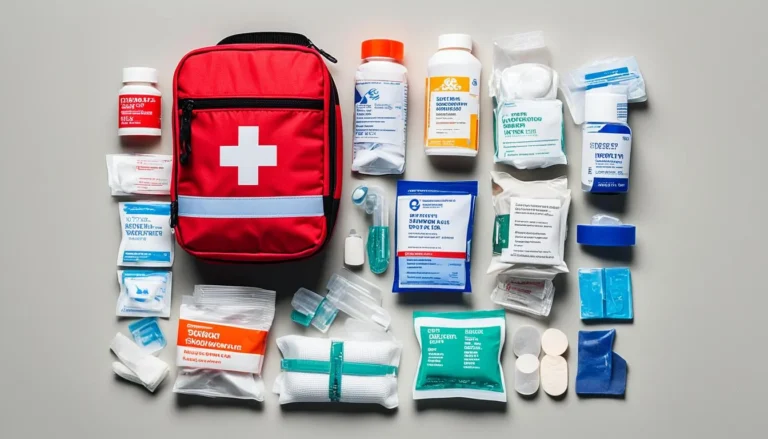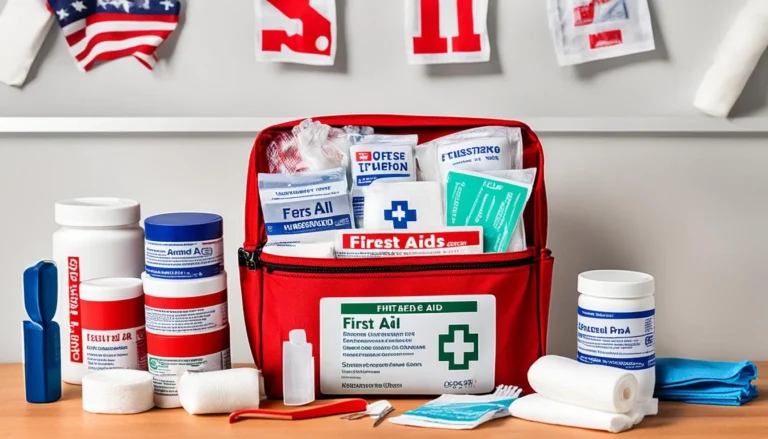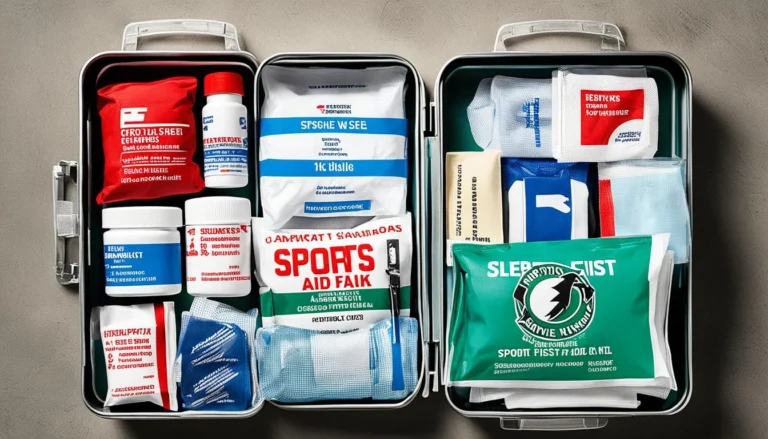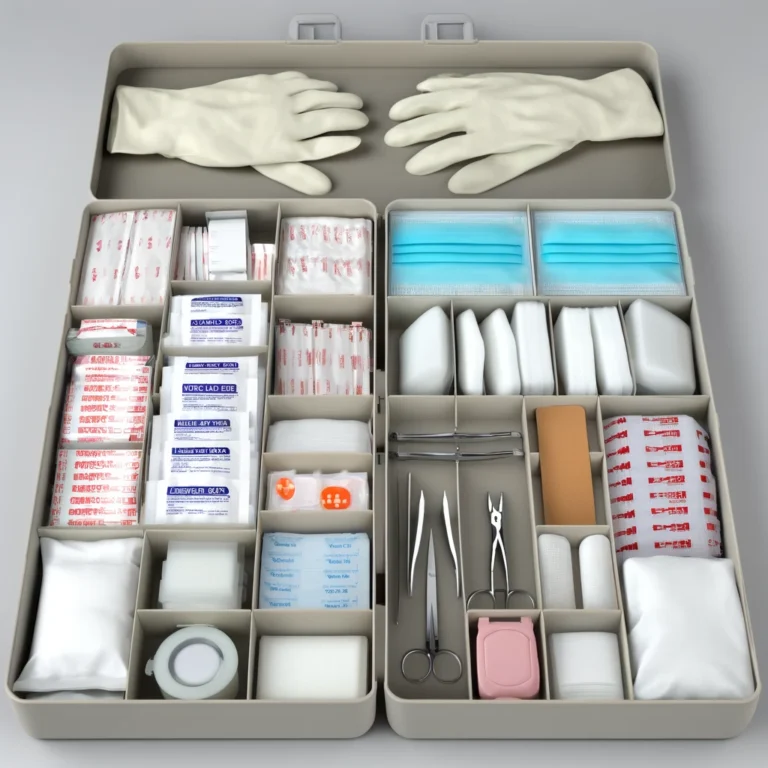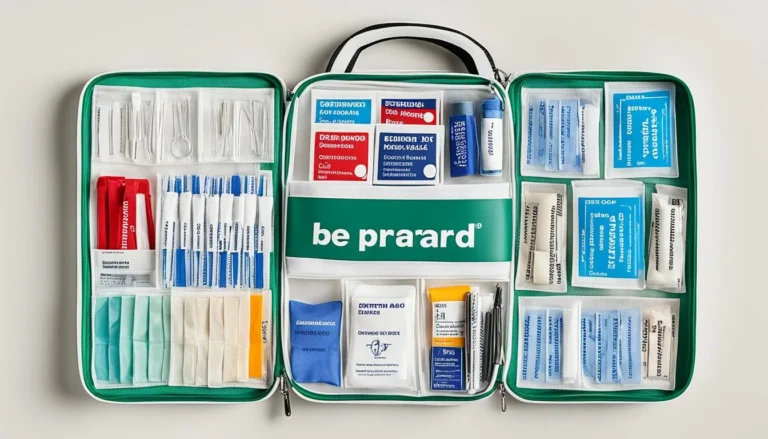What should be in a first aid kit at work
Did you know that over 600,000 workplace injuries happen in the UK each year? This shocking number shows how accidents can happen suddenly. It makes clear the need for first aid kits at work. The right first aid kit is not just about following rules. It is crucial for keeping everyone at work safe and healthy.
It’s very important that first aid kits at work follow strict UK rules. This helps lessen the impact of injuries. Having a good first aid kit shows a company cares about its employees. It also follows the law. Being ready for medical emergencies is key to a safe work environment. It shows safety is very important to the company.
First aid kits at work are not just about meeting legal needs. They show a company’s real care for its team. We will explore the important things needed in a first aid kit at work. We will cover not only the “what” but also the “why” behind each item.
Key Takeaways
- Understanding the critical importance of workplace first aid kits in the face of high injury statistics.
- Recognising the role of UK compliance first aid in safeguarding employees’ health and safety at work.
- The necessity of meeting and exceeding legal compliance requirements for workplace safety.
- Identifying what makes a workplace first aid kit fit for purpose in diverse work environments.
- Adopting a proactive approach to office health and safety through proper first aid preparation.
Understanding the Importance of Workplace First Aid Kits
Workplace safety is very important for employees’ well-being and business operations. A key part of this is having fully-equipped first aid kits. These kits are essential for handling workplace incidents quickly. They help create a secure work environment.
The Basics of Occupational Health and Safety
Occupational health and safety keeps UK workplaces safe. It stops injuries and illnesses. Workplace first aid kits are very important in this. They are ready to help right after an incident. This can save lives.
Legal Requirements for First Aid in the UK Workplace
In the UK, employers must follow first aid laws to keep workplaces safe. The health and Safety (First-Aid) Regulations 1981 set these rules. Employers must have the right first aid equipment and people. This shows they care about their workers’ safety.
Benefits of a Well-Stocked First Aid Kit at Work
A good first aid kit is crucial for safety at work. It can make injuries less bad and helps people get better faster. This also means less time off because of accidents. It shows employees that their health matters. This is good for their feeling of worth and how much they work.
Essential Components of a Work First Aid Kit
Every work first aid kit is very important for safety. It should have what is needed to care for injuries. This includes things for small injuries and bigger ones too. Having the right items can really help give care quickly and well.
Different Types of Bandages and Their Uses
Bandages are very important in any first aid kit. They help with many kinds of injuries. Some bandages stick on cuts while others wrap around to stop swelling or keep a limb still. The stretchy ones are good because they fit on any body part well.
Importance of Sterilisation: Antiseptic Wipes and Creams
Keeping things clean in first aid is very crucial. This stops infections. Things like wipes and creams clean wounds well. These products kill germs which helps healing and stops more problems.
Tools for Injury Management: Scissors, Tweezers, and Safety Pins
For handling injuries, having the right tools matters a lot. Scissors must be sharp for cutting stuff easily. Tweezers pick up small bits like splinters. Safety pins hold bandages or slings. These tools help with many first aid jobs and get you ready for anything.
- Bandages: Various sizes for different injuries.
- Antiseptic supplies: Wipes and creams to prevent infection.
- Injury management tools: Scissors, tweezers, and safety pins for effective first aid.
Specialised Supplies for Specific Workplace Hazards
Every workplace has its own safety challenges. It’s important to make a safety and first aid plan that fits. Knowing the dangers helps you build a good first aid kit.
Identifying Potential Risks in Your Work Environment
Finding potential risks is key. You must look at how your workplace runs. This includes checking all equipment and substances. Risks vary from minor injuries in offices to big ones in factories.
Customised Items for Industrial and Chemical Workplaces
Industrial areas need a bigger first aid kit. Such places may need burn care and eye wash stations. It’s also vital to know how to use these items during emergencies.
Suitable Additions for Office-Based and Low-Risk Areas
Office first aid focuses on small injuries. Things like bandages and painkillers are important. But having defibrillators and knowing how to use them is also a good idea. It’s always better to be prepared.
What Should Be in a First Aid Kit at Work
Keeping employees safe is very important in any job. A first aid kit is needed, not just because it’s the law. It helps with health and safety at work. Your kit should be easy to get to and ready for small injuries and urgent situations. The complete first aid kit checklist here will help you. It shows what you need for a good first aid kit.
| Category | Items | Quantity |
|---|---|---|
| Basic Supplies | Sterile plasters in assorted sizes | 40 |
| Sterile gauze dressings | 4 | |
| Triangular bandages | 2 | |
| Injury Management | Rolled bandages | 3 |
| Eye pad dressings | 2 | |
| Safety pins | 12 | |
| Sterilisation | Antiseptic wipes | 10 |
| Tools & Protection | Disposable sterile gloves | 2 pairs |
| Scissors | 1 | |
| Tweezers | 1 | |
| Safety Equipment | Resuscitation face shield | 1 |
| Thermal blanket | 1 | |
| Additional Items | Saline eye wash | 2 bottles |
| Adhesive tape | 1 roll | |
| Information | First aid manual or instruction leaflet | 1 |
The first aid kit checklist helps keep your team safe. It’s key to customize your kit for your job’s specific dangers. Make sure to check and refill your safety equipment regularly. This shows you really care about your team’s safety at work.
Medications to Include in a Corporate First Aid Kit
Putting together a first aid kit for work needs care in choosing medications. It’s key to have different meds ready. This helps with minor workplace sicknesses and injuries, like headaches and allergies.
Overview of Over-the-Counter Medicines
Over-the-counter (OTC) meds are essential for any first aid kit. These meds help right away with common problems. Picking safe, common meds is important. They help manage workplace sicknesses fast. This keeps everyone productive and healthy.
Considering Allergy and Pain Relief Medications
Choosing the right painkillers and allergy meds is about knowing common issues. Painkillers like paracetamol and ibuprofen are musts. Antihistamines help with allergies. Having a mix of these meds provides quick relief.
Guidelines for Storing Medications Safely
Keeping meds safe is about more than rules. It keeps them effective and clean. Medications must be kept cool and dry. This stops them from going bad. Also, check dates often. This makes sure they’re safe to use. Keep meds in their original packs for easy ID and use.
- Ensure OTC medications like painkillers and antihistamines are always available.
- Check expiry dates monthly and restock as necessary.
- Store medications in a designated area, apart from other first aid supplies to prevent cross-contamination.
Having the right first aid meds and following storage rules shows care for workers’ health. It makes a safer, healthier workplace for everyone.
Ensuring Accessibility and Visibility of the First Aid Kit
The workplace is always busy. Making accessible first aid easy to reach is key. First aid kits need to be where people can get them quickly. We must understand the role of first aid kit placement and safety signage in keeping the workplace safe and efficient.
Strategic Placement of First Aid Kits within the Workplace
Thinking carefully about where to put first aid kits helps with fast emergency help. The best spots for first aid kit placement are near danger zones and common areas. This helps everyone reach them quickly when needed.
It’s important to put kits where they are easy to find during work hours. This ensures quick action in emergencies.
Marking and Signage for Quick Identification
Clear safety signage makes first aid kits easy to spot. Signs must be bright, clear, and follow UK rules. This helps newcomers find first aid kits fast.
Signs should be well-lit and easy to see from far away. They guide people to help and tools during emergencies.
Maintaining First Aid Kit Accessibility for All Employees
Accessible first aid means thinking about everyone. Consider different working hours and make sure kits can be reached by all, including those with disabilities. Training and drills teach employees how to use first aid correctly.
Regular Maintenance: Keeping Your First Aid Kit Up to Date
First aid maintenance is more than just following rules. It’s about keeping your team safe. Let’s look at how to keep your first aid kit ready and correct. It helps prepare you for any accidents at work.
Checking Expiry Dates and Replenishing Supplies
Checking expiry dates is very important in keeping your kit safe. An old item may not work or could be harmful. Check every month and replace old items. This keeps your kit ready to help at all times.
Record Keeping and Inventory Management
Keep a detailed list of what’s in your first aid kit. Note down how much you have, when items expire, and how often you use them. This helps you know when to get new supplies. It ensures your kit is always complete.
Training Staff on First Aid Kit Usage
Teaching your staff how to use the first aid kit is very important. They should know what each item does and how to act in emergencies. Keep teaching them regularly. This makes sure they can give first aid well if needed.
Updating your kit, keeping good records, and training everyone are key. They make your first aid response strong. And they keep your workplace safer for everyone.
Training Employees on First Aid Kit Usage
It’s vital that workers can use first aid kits well with first aid training. Giving first aid quickly lessens injury effects and boosts a strong workplace safety culture. We need to know about appointed persons and first aiders’ roles and give ongoing training.
The Role of Appointed Persons and First Aiders
Choosing the right people to look after first aid supplies and handle emergencies is key. These appointed persons start the response to injuries. They work with trained first aiders, who know more from first aid training. Together, they ensure someone always knows what to do if something happens.
Organising Regular First Aid Training Sessions
Regular first aid training sessions are important. They keep everyone’s skills up to date and share new advice. This means everyone knows where first aid kits are and how to use them. It keeps the team ready and confident to help anytime.
Creating a Culture of Safety and Preparedness at Work
Having a safe workplace safety culture is more than a rule. It’s about making a place where everyone thinks safety first. Holding drills and talking about safety makes everyone more ready to prevent and handle accidents. This way, safety becomes part of the company’s heart.
Conclusion
We talked about how important first aid compliance is for UK employers. Employers must ensure their first aid kits meet high standards. This helps prevent workplace injuries.
First aid resources must always be ready and in good condition. A full, up-to-date kit helps with quick and effective help in emergencies. This shows a business cares a lot about its people.
Following our advice leads to a safe and ready workplace. First aid kit final thoughts show how being ready helps prevent bad things. We want this article to make businesses better protect their people.


